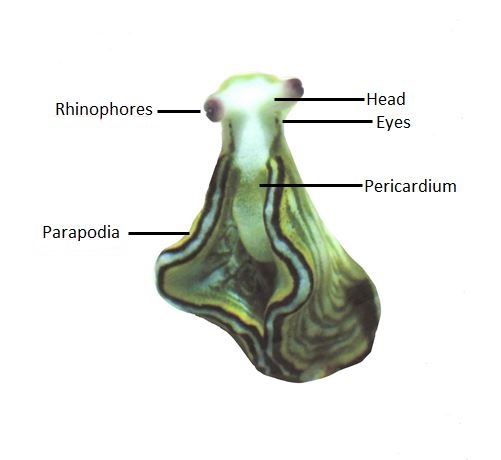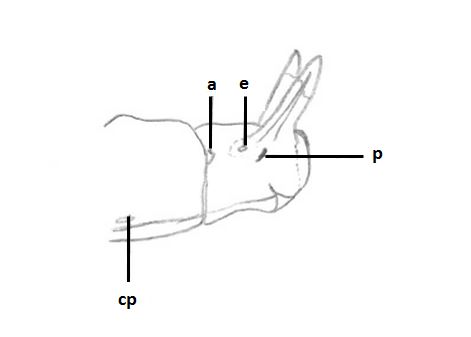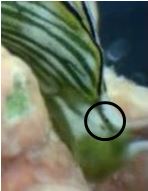Summary
Physical Description
Size and Colouration
External Anatomy
Ecology
Local Distribution and Microhabitat
Life History & Behaviour
Reproduction
Development and Locomotion
Feeding and Respiration
Behavioural Observations
Anatomy & Physiology
Internal Anatomy
Histological Sectioning
Evolution & Systematics
Phylogeny and Kleptoplasty
Biogeographic Distribution
Conservation & Threats
References & Links
Reference List
Useful Links
Glossary | External Anatomy
Like many other species of Elysia, the pericardium is quite pronounced in this species, and was seen to be approximately one third of the body length. It is located just posterior to the head along the midline of the body, and is mostly visible even when the parapodia are at their most erect and meet along the midline of the body. The below video shows the large size of the pericardium, and the frequency with which it beats. The eyes of Elysia sp. appear quite rudimentary and are certainly less pronounced than in other species of Elysia, but can be seen immediately posterior to the rhinophores and shifted slightly ventrally compared with other species (refer Figure 3). Figure 1 below indicates the more obvious external anatomy, though the eyes are not overly visible in this picture. For a clearer view of the eyes of Elysia sp. see the video on the Feeding and Locomotion page, in which the eyes are particularly visible at around 2.20 minutes in. Figure 3 below shows a more detailed view of the anterior end of Elysia filicaudata, and as it is generally accepted that for most Elysiids the penis is located below the right rhinophore and that the anus is located anterior to the pericardium on the right side it would be reasonable to assume that this biology is the same in Elysia sp. Though much of the external anatomy is conserved across the Elysiidae, colouration patterns are often unique and can therefore be used as a diagnostic tool. A particularly useful site indexing the vast majority of sea slug species is the Sea Slug Forum site set up by Bill Rudman (formerly of the Australian Museum), which is an excellent site for identification of sea slug species.
 Figure 1- The major external anatomy of Elysia sp. Note that although dorsal vessels are present, they are more difficult to view in this image.
Figure 1- The major external anatomy of Elysia sp. Note that although dorsal vessels are present, they are more difficult to view in this image.

Figure 2- Anterior end lateral view of external anatomy features of Elysia filicaudata where p=penis; cp=copulatory pad; e=eye and a=anus. Adapted from Jensen, 1992 [1].

Figure 3- Rudimentary eye in Elysia sp. located just posterior to the rhinophore
Video- Beating pericardium in Elysia sp.
|
|